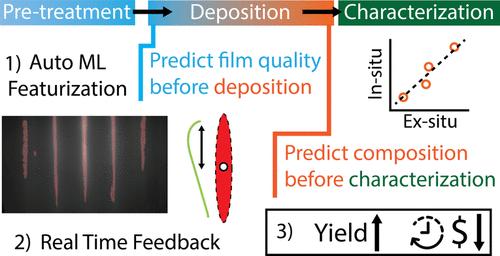当前位置:
X-MOL 学术
›
Nano Lett.
›
论文详情
Our official English website, www.x-mol.net, welcomes your
feedback! (Note: you will need to create a separate account there.)
Predicting and Accelerating Nanomaterial Synthesis Using Machine Learning Featurization
Nano Letters ( IF 9.6 ) Pub Date : 2024-11-12 , DOI: 10.1021/acs.nanolett.4c04500 Christopher C. Price, Yansong Li, Guanyu Zhou, Rehan Younas, Spencer S. Zeng, Tim H. Scanlon, Jason M. Munro, Christopher L. Hinkle
Nano Letters ( IF 9.6 ) Pub Date : 2024-11-12 , DOI: 10.1021/acs.nanolett.4c04500 Christopher C. Price, Yansong Li, Guanyu Zhou, Rehan Younas, Spencer S. Zeng, Tim H. Scanlon, Jason M. Munro, Christopher L. Hinkle

|
Materials synthesis optimization is constrained by serial feedback processes that rely on manual tools and intuition across multiple siloed modes of characterization. We automate and generalize feature extraction of reflection high-energy electron diffraction (RHEED) data with machine learning to establish quantitatively predictive relationships in small sets (∼10) of expert-labeled data, saving significant time on subsequently grown samples. These predictive relationships are evaluated in a representative material system (W1–xVxSe2 on c-plane sapphire (0001)) with two aims: 1) predicting grain alignment of the deposited film using pregrowth substrate data and 2) estimating vanadium dopant concentration using in situ RHEED as a proxy for ex situ methods (e.g., X-ray photoelectron spectroscopy). Both tasks are accomplished using the same materials-agnostic features, avoiding specific system retraining and leading to a potential 80% time saving over a 100-sample synthesis campaign. These predictions provide guidance to avoid doomed trials, reduce follow-on characterization, and improve control resolution for materials synthesis.
中文翻译:

使用机器学习特征化预测和加速纳米材料合成
材料合成优化受到串行反馈过程的限制,这些过程依赖于手动工具和跨多个孤立表征模式的直觉。我们通过机器学习对反射高能电子衍射 (RHEED) 数据进行自动化和泛化特征提取,以在专家标记数据的小集合 (∼10) 中建立定量预测关系,从而为后续生长的样品节省大量时间。这些预测关系在代表性材料系统(c 平面蓝宝石 (0001) 上的 W 1-xVxSe2))中进行评估,其两个目标:1) 使用预生长衬底数据预测沉积薄膜的晶粒排列,以及 2) 使用原位 RHEED 作为非原位方法的代理估计钒掺杂剂浓度(例如,X 射线光电子能谱)。这两项任务均使用相同的材料无关功能完成,避免了特定的系统重新训练,与 100 个样品的合成相比,可节省 80% 的时间。这些预测为避免注定失败的试验、减少后续表征和提高材料合成的控制分辨率提供了指导。
更新日期:2024-11-12
中文翻译:

使用机器学习特征化预测和加速纳米材料合成
材料合成优化受到串行反馈过程的限制,这些过程依赖于手动工具和跨多个孤立表征模式的直觉。我们通过机器学习对反射高能电子衍射 (RHEED) 数据进行自动化和泛化特征提取,以在专家标记数据的小集合 (∼10) 中建立定量预测关系,从而为后续生长的样品节省大量时间。这些预测关系在代表性材料系统(c 平面蓝宝石 (0001) 上的 W 1-xVxSe2))中进行评估,其两个目标:1) 使用预生长衬底数据预测沉积薄膜的晶粒排列,以及 2) 使用原位 RHEED 作为非原位方法的代理估计钒掺杂剂浓度(例如,X 射线光电子能谱)。这两项任务均使用相同的材料无关功能完成,避免了特定的系统重新训练,与 100 个样品的合成相比,可节省 80% 的时间。这些预测为避免注定失败的试验、减少后续表征和提高材料合成的控制分辨率提供了指导。


















































 京公网安备 11010802027423号
京公网安备 11010802027423号